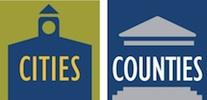Air Quality Programs
 California regions are required to be in compliance with federal air quality standards set by the U.S. Environmental Protection Agency. As a result, regional air quality management districts and air pollution control districts (air districts) work with local governments to create plans, policies and programs which reduce the need for vehicle travel – a significant cause of air pollution.
California regions are required to be in compliance with federal air quality standards set by the U.S. Environmental Protection Agency. As a result, regional air quality management districts and air pollution control districts (air districts) work with local governments to create plans, policies and programs which reduce the need for vehicle travel – a significant cause of air pollution.
Transportation demand management efforts at air districts include project review of proposed developments, strategies to reduce air pollution through bicycle/pedestrian infrastructure and Spare the Air programs.
| Examples: |
|
The Imperial Valley and San Joaquin Valley Air Pollution Control Districts implemented an “Indirect Source Rule.” The indirect source rule allows the districts to collect revenue from high-polluting and/or new developments and use the funds to mitigate air pollution through transportation demand management strategies in local communities. Indirect emission sources include air pollution from increased truck and car traffic, energy demanded by new homes and businesses, increased heating and cooling and construction vehicles. |




